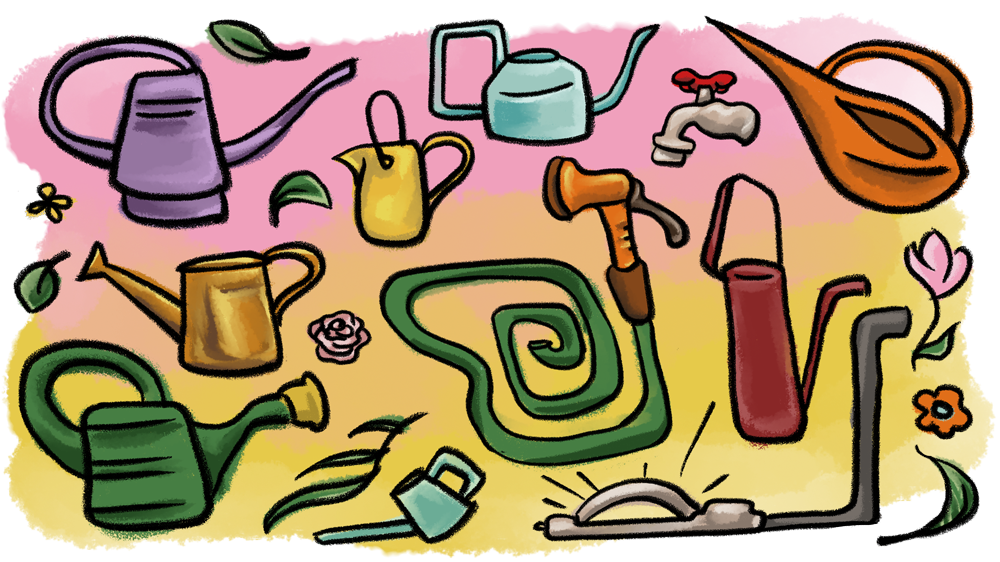
Article and illustrations by Holly Cohick
Green thumb or not, here is how to water your precious plants in the heat of summer. Plants need just the right amount of water to thrive. To do that, you need to take their age and environment into account. Your parched plants would enjoy a drink at any hour of the day, but watering is more effective at certain times. You can help keep your garden healthy with mulch and by using the watering tool that matches the plant.
Goldilocks Water
Yes, plants need water to stay strong and healthy. However, too much water can also be detrimental to their health. If you water too often for shallow surface watering, this hinders healthy, deep root growth. Water them sparsely and they do not get enough nutrients to stay alive.
Potted outside plants living in a container tend to get thirsty more often than soil in a plotted garden. For outside plants and houseplants, make sure these containers have drainage holes. If water does not have a chance to drain, it can accumulate and make the soil soggy and create rotting.

Scratching the Surface on Where to Water
On a hot or windy day, sprinkling your plants on the leaves can cause water to evaporate before it ever reaches where it needs to go. If you are not using rain barrel water, the chlorine and sodium in your tap or hose water, when evaporated, leaves remnants. This coupled with a hot sun can scorch leaves. Water your plants at the base where the soil is. It is through the roots that the plant takes in water. It is best practice to water in the morning while there may still be dew. Watering in the evening is fine as well, but the cold dampness of the night is a good environment for fungus. A good gardener knows to minimize the plant’s wetness time to lessen the risk of fungal disease.
Consistency is Key
Have you ever noticed cracks in produce? This is caused by the fruit or vegetable’s skin expanding due to a sudden rainfall after a drought. Keep the watering on a schedule and modify it based on the rainfall.
To keep the soil consistently moist for trees and shrubs that are newly planted, water thoroughly two or three times per week for the first month. Afterwards, water them weekly during their first growing season. Established trees and shrubs of two years of age or older can be watered every other week during the growing season when rain is sparse.
Weakest Link
It is impossible to make all your plants happy 100 percent of the time. Take notice of a plant that wilts first. That indicates it is too dry and you should water the garden. Your indicator plant will most likely be a cucumber, squash, or melon as they have large leaves, which lose moisture fast.

Comfort Blanket
Mulch, like wheat straw, shredded leaves, or ground bark, spread on the ground acts as an umbrella against the squelching sun. This helps keep soil moist and plant roots cool. Without this two-to-three-inch barrier, hot weather dries up the ground and you end up watering more.
Cans and the Wonders of a Water Wand
Please save your fragile foliage and blossomed container plants by not using a jet spray nozzle. This can damage them and disturb soil around the roots. Save your back with a watering wand. They reach where you cannot in high or low places. This is a good way to conserve water because you are controlling the amount used directly to the soil. If you do not possess a watering wand or watering can, remove the nozzle from the garden hose and let the water run out slowly. On the flipside, a sprinkler would not adequately water your plants unless you are caring for your lawn or widespread ground covers.


